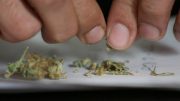A class action lawsuit was filed last week against Puna Geothermal Venture over its gas release two years ago during Tropical Storm Iselle.
Six plaintiffs — George Douvris, Stephanie Douvris, Michael Hale, Cheryl Carocci, Hillary Wilt and Christina Bryan — filed the lawsuit Friday in Hilo Circuit Court on behalf of themselves and other lower Puna residents impacted by the release, that included venting of hydrogen sulfide, a toxic gas.
They are represented by Honolulu attorney Patrick Kyle Smith, who successfully sued DuPont Pioneer for the spread of red dust from test fields on Kauai, and Hilo attorneys Charles Heaukulani and Gary Zamber. Multiple attempts to reach them for comment were unsuccessful.
An estimated 67 pounds of hydrogen sulfide was vented Aug. 7, 2014, as Iselle began battering the Big Island. The plant was disconnected from the grid because of fallen trees, prompting it to shutdown and release steam.
Fallen trees and other storm hazards also prevented nearby residents from leaving their homes as the venting occurred.
The plaintiffs argue PGV was negligent in keeping the 38-megawatt power plant operating as the storm made landfall.
The lawsuit says “PGV’s conduct has caused injury both to the land and health of Plaintiffs,” who seek exemplary or punitive damages.
The lawsuit says the class consists of hundreds of lower Puna residents.
Some nearby residents said they smelled a strong rotten egg odor, often associated with hydrogen sulfide, and experienced scratchy throats, rashes and headaches following the release. Hale told the Tribune-Herald in August 2014 that he fell unconscious.
The power outage also left air monitoring stations nearby offline, making it difficult to determine the risk.
PGV said handheld monitors used by its employees detected hydrogen sulfide readings as high as 39 parts per billion at the plant and 25 ppb along its property fence line.
Its air permit limits fence line readings to 25 ppb on an average hourly basis.
A state Department of Health official said those readings would be within safety limits.
The Occupational Safety and Health Administration limits workplace exposure to 10,000 ppb, according to PGV.
In June, the Windward Planning Commission approved spending $362,719 on a plume study to model dispersion of hydrogen sulfide from venting at PGV. The funding comes from Hawaii County’s geothermal asset fund.
Meanwhile, a study to determine whether there are health impacts from geothermal power production has yet to be launched, two years after the county issued a request for proposals.
Clarysse Nunokawa, executive assistant to Mayor Billy Kenoi, said proposals are still being evaluated.
A PGV spokesman didn’t return a request for comment by deadline.
Email Tom Callis at [email protected].
Source: hawaiitribune-herald.com





Be the first to comment on "PGV Sued for Gas Leak; Class Action Lawsuit Seeks Compensation for Hydrogen Sulfide Exposure"